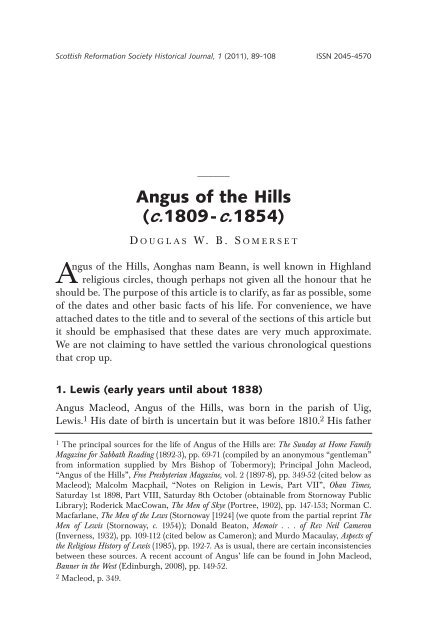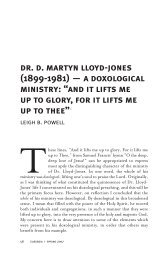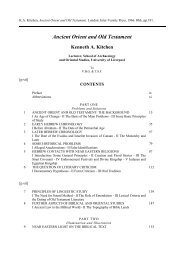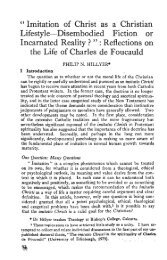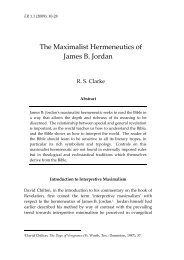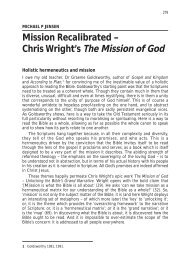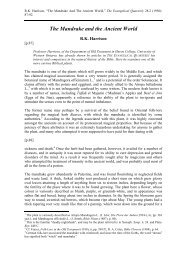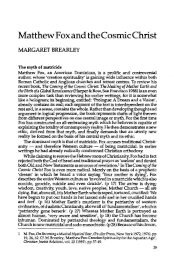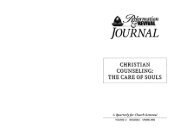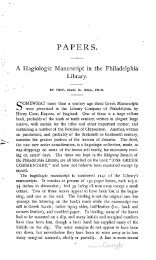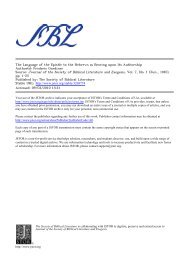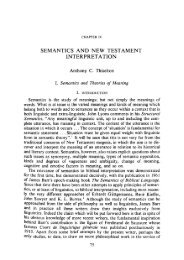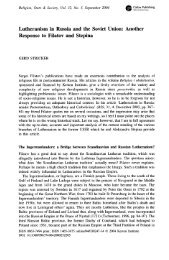Angus of the Hills (c.1809-c.1854) - BiblicalStudies.org.uk
Angus of the Hills (c.1809-c.1854) - BiblicalStudies.org.uk
Angus of the Hills (c.1809-c.1854) - BiblicalStudies.org.uk
You also want an ePaper? Increase the reach of your titles
YUMPU automatically turns print PDFs into web optimized ePapers that Google loves.
Scottish Reformation Society Historical Journal, 1 (2011), 89-108 ISSN 2045-4570<br />
______<br />
<strong>Angus</strong> <strong>of</strong> <strong>the</strong> <strong>Hills</strong><br />
(<strong>c.1809</strong>-<strong>c.1854</strong>)<br />
D OUGLAS W. B. SOMERSET<br />
<strong>Angus</strong> <strong>of</strong> <strong>the</strong> <strong>Hills</strong>, Aonghas nam Beann, is well known in Highland<br />
religious circles, though perhaps not given all <strong>the</strong> honour that he<br />
should be. The purpose <strong>of</strong> this article is to clarify, as far as possible, some<br />
<strong>of</strong> <strong>the</strong> dates and o<strong>the</strong>r basic facts <strong>of</strong> his life. For convenience, we have<br />
attached dates to <strong>the</strong> title and to several <strong>of</strong> <strong>the</strong> sections <strong>of</strong> this article but<br />
it should be emphasised that <strong>the</strong>se dates are very much approximate.<br />
We are not claiming to have settled <strong>the</strong> various chronological questions<br />
that crop up.<br />
1. Lewis (early years until about 1838)<br />
<strong>Angus</strong> Macleod, <strong>Angus</strong> <strong>of</strong> <strong>the</strong> <strong>Hills</strong>, was born in <strong>the</strong> parish <strong>of</strong> Uig,<br />
Lewis. 1 His date <strong>of</strong> birth is uncertain but it was before 1810. 2 His fa<strong>the</strong>r<br />
1 The principal sources for <strong>the</strong> life <strong>of</strong> <strong>Angus</strong> <strong>of</strong> <strong>the</strong> <strong>Hills</strong> are: The Sunday at Home Family<br />
Magazine for Sabbath Reading (1892-3), pp. 69-71 (compiled by an anonymous “gentleman”<br />
from information supplied by Mrs Bishop <strong>of</strong> Tobermory); Principal John Macleod,<br />
“<strong>Angus</strong> <strong>of</strong> <strong>the</strong> <strong>Hills</strong>”, Free Presbyterian Magazine, vol. 2 (1897-8), pp. 349-52 (cited below as<br />
Macleod); Malcolm Macphail, “Notes on Religion in Lewis, Part VII”, Oban Times,<br />
Saturday 1st 1898, Part VIII, Saturday 8th October (obtainable from Stornoway Public<br />
Library); Roderick MacCowan, The Men <strong>of</strong> Skye (Portree, 1902), pp. 147-153; Norman C.<br />
Macfarlane, The Men <strong>of</strong> <strong>the</strong> Lews (Stornoway [1924] (we quote from <strong>the</strong> partial reprint The<br />
Men <strong>of</strong> Lewis (Stornoway, c. 1954)); Donald Beaton, Memoir . . . <strong>of</strong> Rev Neil Cameron<br />
(Inverness, 1932), pp. 109-112 (cited below as Cameron); and Murdo Macaulay, Aspects <strong>of</strong><br />
<strong>the</strong> Religious History <strong>of</strong> Lewis (1985), pp. 192-7. As is usual, <strong>the</strong>re are certain inconsistencies<br />
between <strong>the</strong>se sources. A recent account <strong>of</strong> <strong>Angus</strong>’ life can be found in John Macleod,<br />
Banner in <strong>the</strong> West (Edinburgh, 2008), pp. 149-52.<br />
2 Macleod, p. 349.
90 DOUGLAS W. B. SOMERSET<br />
was living at this time in <strong>the</strong> village <strong>of</strong> Carishader but when <strong>Angus</strong><br />
was a few years old he moved to Aird Bheag, a remote spot on <strong>the</strong> south<br />
side <strong>of</strong> Loch Hamanaway. The family included two sisters who were<br />
simpletons like <strong>Angus</strong>, ano<strong>the</strong>r sister Mary who was married in Brenish,<br />
and a bro<strong>the</strong>r Murdo who settled in Doune, Carloway in 1872. During<br />
his childhood <strong>Angus</strong> would sometimes tear <strong>of</strong>f his clo<strong>the</strong>s and injure<br />
himself with rocks in a manner resembling <strong>the</strong> demoniac Legion. 3 From<br />
<strong>the</strong> various anecdotes, it does not seem that <strong>Angus</strong>’ fa<strong>the</strong>r was spiritually<br />
touched by <strong>the</strong> Lewis revival. There is no mention <strong>of</strong> his mo<strong>the</strong>r in any<br />
<strong>of</strong> <strong>the</strong> accounts.<br />
The Lewis revival began in 1822 but <strong>the</strong> parish <strong>of</strong> Uig remained<br />
unaffected by it until <strong>the</strong> settlement <strong>of</strong> Alexander Macleod in Uig on<br />
28th April 1824. Indeed shortly before Macleod’s arrival <strong>the</strong>re were only<br />
two or three Bibles in <strong>the</strong> entire parish. 4 The revival spread to Uig within<br />
about a month <strong>of</strong> his settlement, but for two years he refused to celebrate<br />
communion because <strong>of</strong> <strong>the</strong> ignorance <strong>of</strong> <strong>the</strong> people. When eventually a<br />
communion was held, on 24th June 1827, <strong>the</strong> assisting minister, who<br />
arrived unexpectedly, was John Macdonald, <strong>the</strong> Apostle <strong>of</strong> <strong>the</strong> North.<br />
The congregation numbered seven thousand, but only six <strong>of</strong> <strong>the</strong> eight<br />
hundred to a thousand members in Uig communicated, and many who<br />
were under concern or who were converted were afraid to come forward.<br />
At <strong>the</strong> communion <strong>the</strong> following year <strong>the</strong> congregation numbered nine<br />
thousand, but probably <strong>the</strong>re were no more than about fifteen<br />
communicants from Uig. 5<br />
<strong>Angus</strong> was converted sometime in <strong>the</strong> late 1820s, probably while<br />
still in his teens. “This complete change in his life took place on hearing,<br />
at a meeting on <strong>the</strong> hillside, some text spoken which lodged itself in his<br />
heart.” Thereafter he became very attached to Alexander Macleod and<br />
his wife. 6 He was one <strong>of</strong> <strong>the</strong> early converts <strong>of</strong> <strong>the</strong> Uig revival, 7 and was<br />
3 Macleod, p. 349; Macaulay, p. 192; Sunday at Home, p. 69.<br />
4 Disruption Worthies <strong>of</strong> <strong>the</strong> Highlands (Edinburgh, 1877), p. 222; Macleod, p. 349.<br />
5 Donald Beaton (ed), Diary and Sermons <strong>of</strong> Rev Alexander Macleod (Inverness, 1925), pp. 10,<br />
14, 19; John Kennedy, The Apostle <strong>of</strong> <strong>the</strong> North (Inverness, 1932), p. 276; History <strong>of</strong> Revivals<br />
<strong>of</strong> Religion in <strong>the</strong> British Isles (Edinburgh, 1836), p. 363. In 1833 <strong>the</strong>re were sixty<br />
communicant members, according to <strong>the</strong> Statistical Account, giving an average increase <strong>of</strong><br />
nine a year since 1827. In 1834 <strong>the</strong>re were thirty-one male heads-<strong>of</strong>-household in Uig who<br />
were communicant members; see John Macleod, A Brief Record <strong>of</strong> <strong>the</strong> Church in Uig (Lewis)<br />
(Uig, 2001), p. 9.<br />
6 Sunday at Home, pp. 69, 71.<br />
7 Norman C. Macfarlane, Apostles <strong>of</strong> <strong>the</strong> North (Stornoway, 1931), p. 38 (in 1990s reprint).
ANGUS OF THE HILLS 91<br />
friendly with John Macrae (Big Macrae) who was teaching in <strong>the</strong> parish<br />
<strong>of</strong> Uig from about 1825 onwards. Macrae was licensed by <strong>the</strong> Presbytery<br />
<strong>of</strong> Lewis on 7th September 1830 and became assistant in Gairloch soon<br />
afterwards, so <strong>Angus</strong>’ conversion must have occurred well before that<br />
date. The first time that <strong>Angus</strong> came before <strong>the</strong> Uig kirk session he was<br />
refused admission on <strong>the</strong> grounds <strong>of</strong> his idiocy. 8 Had this been <strong>the</strong> 1827<br />
communion, one feels that such an interesting circumstance would have<br />
been mentioned, so it was probably <strong>the</strong> 1828 communion at which he<br />
first applied. Thus it was probably <strong>the</strong> 1829 communion at which he was<br />
accepted by <strong>the</strong> kirk session.<br />
In September 1829 Robert Finlayson, whose wife was from Uig,<br />
became minister <strong>of</strong> Knock; and in June 1831 he moved to Lochs where<br />
he continued until 1856. There is an anecdote, in different versions, <strong>of</strong><br />
Finlayson interviewing two or three women in his congregation<br />
regarding <strong>the</strong>ir conversions. The first one was reluctant to answer but<br />
eventually disclosed that it was hearing <strong>Angus</strong> pray in private that led to<br />
her conversion. The second woman said that it was hearing <strong>the</strong> first<br />
woman describe <strong>Angus</strong>’ prayer that led to her conversion. The third<br />
woman had been converted through Finlayson’s ministry. This incident<br />
probably dates from <strong>the</strong> early part <strong>of</strong> Finlayson’s ministry in Lochs. 9<br />
In July 1833, or soon afterwards, John Macrae was settled as<br />
minister in Cross, and a couple <strong>of</strong> well known anecdotes about <strong>Angus</strong><br />
date from this period. 10 For a reason that will be mentioned in Section 3,<br />
it seems likely that <strong>Angus</strong> was largely resident in Cross ra<strong>the</strong>r than Uig<br />
after 1833.<br />
2. Skye and Lochalsh (1838-1846)<br />
In February 1838, Roderick Macleod moved from Bracadale to become<br />
minister <strong>of</strong> Snizort and it was probably about this time that <strong>Angus</strong><br />
started attending communions in Skye. There is no record <strong>of</strong> <strong>Angus</strong><br />
having been in Bracadale and <strong>the</strong>re was no o<strong>the</strong>r minister on <strong>the</strong> island<br />
at that stage whose communions <strong>Angus</strong> would have wished to attend.<br />
<strong>Angus</strong> soon became greatly attached to Roderick Macleod. 11 “Once<br />
8 Macfarlane, Men, p. 19.<br />
9 Macphail, part VII; Sunday at Home, p. 71; Macfarlane, Men, p. 20.<br />
10 Macleod, pp. 350-1; Cameron, pp. 109-110.<br />
11 Macleod, p. 351.
92 DOUGLAS W. B. SOMERSET<br />
he came to Skye,” says MacCowan, “he seldom left it, and only on<br />
communion occasions went elsewhere.” 12<br />
MacCowan says that <strong>Angus</strong> left Lewis after a row with his fa<strong>the</strong>r<br />
and never returned but this conflicts with Mrs Bishop’s account. 13 Mrs<br />
Bishop, however, was probably less well-informed about <strong>Angus</strong>’ life than<br />
one would ga<strong>the</strong>r from her article. Perhaps <strong>the</strong>re was a second row after<br />
which <strong>Angus</strong> never returned to his fa<strong>the</strong>r’s house, or perhaps he never<br />
returned to Uig. Certainly <strong>the</strong>re seems to have been a period when <strong>Angus</strong><br />
was absent from Lewis. In September 1839 John Macrae left Cross for<br />
Knockbain and in January 1844 Alexander Macleod moved from Uig<br />
to Lochalsh, and both <strong>the</strong>se departures would have loosened <strong>Angus</strong>’<br />
attachment to his native island. Principal Macleod states that <strong>Angus</strong> lived<br />
in Skye after 1846, when Alexander Macleod became minister <strong>of</strong> Rogart,<br />
but we are inclined to think he must have started to live in Skye<br />
considerably before this. 14 Fur<strong>the</strong>rmore, after 1846 he became a frequent<br />
visitor to Tobermory, as we shall soon see, and Mrs Bishop gives <strong>the</strong><br />
impression that he was largely resident in Lewis at that time.<br />
The result <strong>of</strong> Alexander Macleod’s translation to Lochalsh in 1844<br />
was that <strong>Angus</strong> started attending communions <strong>the</strong>re. The Lochalsh Free<br />
Church had been erected in Ardelve by Isaac Lillingston (1802-1850) <strong>of</strong><br />
Balmacara House. He was a nephew <strong>of</strong> William Wilberforce and, though<br />
<strong>the</strong>y belonged to <strong>the</strong> Church <strong>of</strong> England, he and his wife Ka<strong>the</strong>rine<br />
(1811-75) gave warm support to <strong>the</strong> Free Church. His wife was heiress to<br />
Balmacara House which had been built by her great uncle Sir Hugh<br />
Innes, Bt, <strong>of</strong> Lochalsh about 1807. Sir Hugh (1764-1831) was <strong>the</strong> son <strong>of</strong><br />
Hugh Innes (1726-1765), a Cameronian minister, who had embraced <strong>the</strong><br />
Amyraldian views <strong>of</strong> <strong>the</strong> Atonement expressed by Fraser <strong>of</strong> Brea and had<br />
left <strong>the</strong> Cameronians at <strong>the</strong> Breach <strong>of</strong> 1753. 15 The Lillingstones were<br />
married in 1832 and had three surviving children, Charlotte b. 1846,<br />
12 MacCowan, p. 148.<br />
13 MacCowan, p. 148. Mrs Bishop implies that <strong>Angus</strong> was returning to Lewis by <strong>the</strong> late<br />
1840s. In her version <strong>of</strong> <strong>the</strong> row, <strong>Angus</strong>, fleeing after breaking his fa<strong>the</strong>r’s hoe, prayed<br />
for help when he saw <strong>the</strong> anger in his fa<strong>the</strong>r’s eyes. At that moment, his pursuing<br />
fa<strong>the</strong>r stumbled and fractured a bone in his foot. <strong>Angus</strong>, however, instead <strong>of</strong> leaving<br />
home, was greatly concerned and did all that he could to care for his fa<strong>the</strong>r, Sunday at<br />
Home, pp. 70-1.<br />
14 Macleod, p. 351.<br />
15 W. J. Couper, “The Reformed Presbyterian Church in Scotland”, Records <strong>of</strong> <strong>the</strong> Scottish<br />
Church History Society, vol. 2 (Edinburgh, 1925), p. 81.
ANGUS OF THE HILLS 93<br />
Ka<strong>the</strong>rine b. 1847, and Frederick b. 1849. Presumably <strong>the</strong>y had many<br />
bereavements and sorrows between 1832 and 1846. Balmacara house was<br />
sold in 1853, following Mr Lillingstone’s early death, but a part <strong>of</strong> <strong>the</strong><br />
estate remained in Lillingstone hands until 1953.<br />
When <strong>Angus</strong> went to Lochalsh for a communion he was “kindly<br />
received and welcomed” by <strong>the</strong> Lillingstones. It was probably on this<br />
occasion that someone said to <strong>Angus</strong>, “Might you not be proud, <strong>Angus</strong>,<br />
when <strong>the</strong> lady <strong>of</strong> this house asked you to her table?”; to which <strong>Angus</strong><br />
replied, “Indeed; she might ra<strong>the</strong>r think much <strong>of</strong> <strong>the</strong> grace that humbled<br />
her so that she would take poor <strong>Angus</strong> to her table”. The same story is<br />
also told in connection with <strong>Angus</strong>’ visits to <strong>the</strong> Snizort manse, but <strong>the</strong><br />
Lillingstone version seems more likely. 16 Neil Cameron mentions that<br />
<strong>Angus</strong> on one occasion travelled from Lochalsh to Inverness to attend a<br />
communion, and presumably it was at <strong>the</strong> conclusion <strong>of</strong> one <strong>of</strong> his visits<br />
to Lochalsh that <strong>Angus</strong> made <strong>the</strong> journey. 17<br />
3. Tobermory (1847 onwards)<br />
Ano<strong>the</strong>r ministerial settlement <strong>of</strong> significance to <strong>Angus</strong>, which took<br />
place soon after <strong>the</strong> Disruption, was that <strong>of</strong> Peter Maclean in Tobermory.<br />
Peter Maclean (1800-1868) was, like <strong>Angus</strong>, a native <strong>of</strong> Uig, Lewis. He<br />
was converted during <strong>the</strong> revival in November 1825 and <strong>the</strong>n briefly<br />
attended Aberdeen Grammar School, before matriculating at King’s<br />
College, Aberdeen in 1828 where he studied for one year. The following<br />
session he transferred to Edinburgh. He returned to Uig as a teacher<br />
from 1832 to 1836. In 1836 he was licensed by <strong>the</strong> Presbytery <strong>of</strong> Lewis<br />
and <strong>the</strong> next year he was sent out to Whycocomagh, Cape Breton, as an<br />
ordained missionary. 18 He returned to Scotland through ill-health in<br />
1841. At <strong>the</strong> Disruption, he joined <strong>the</strong> Free Church and was settled in<br />
August 1843 at Tobermory. The congregation numbered a thousand but<br />
<strong>the</strong>y were very poor; never<strong>the</strong>less a church was built, and a manse<br />
purchased, within a few months <strong>of</strong> <strong>the</strong> Disruption. Shortly after his<br />
16 Macleod, pp. 351-2.<br />
17 Cameron, p. 111.<br />
18 Rev John MacLeod, Free Presbyterian minister, London, has a copy <strong>of</strong> <strong>the</strong> Edinburgh<br />
Christian Instructor <strong>of</strong> 1839 with <strong>the</strong> inscription “Revd Peter M‘Lean, Whycocomah” – a<br />
volume that was presumably in <strong>the</strong> Tobermory manse during <strong>Angus</strong>’ visits.
94 DOUGLAS W. B. SOMERSET<br />
settlement he married Flora Campbell, “a lady <strong>of</strong> superior piety and gifts<br />
and social position”. 19<br />
The communions in Tobermory were held, as far as we can ga<strong>the</strong>r,<br />
on <strong>the</strong> first Sabbath <strong>of</strong> July and <strong>the</strong> first Sabbath <strong>of</strong> December and<br />
<strong>Angus</strong> became a regular visitor at <strong>the</strong>se. He came with “Mistress Peggie<br />
McKenzie” from Lewis who was “well known throughout <strong>the</strong> Isles for her<br />
eminent life and character”. “<strong>Angus</strong>,” it is said, “had attached himself<br />
to her so strongly that a separation could not be thought <strong>of</strong>. At <strong>the</strong><br />
half-yearly communion Mistress McKenzie used to come and stay at <strong>the</strong><br />
Free Church manse, and was always accompanied by <strong>Angus</strong>, who was<br />
accommodated in some ‘bothain’ not far <strong>of</strong>f. He was allowed free ingress<br />
at <strong>the</strong> manse, and would run in and out, and follow his friends about<br />
‘just like a doggie’. A word from Mistress McKenzie was law to him; at a<br />
look, or a sign <strong>of</strong> her uplifted finger, he would instantly stop when she<br />
thought he was talking too much. His reverence and affection for her<br />
were unbounded.” 20<br />
Neil Cameron, who was from <strong>the</strong> parish <strong>of</strong> Kilninver near Mull,<br />
relates than on one occasion Ewen Cameron, who was similar to<br />
<strong>Angus</strong> in piety and in simplicity, also attended <strong>the</strong> communion at<br />
Tobermory, and that he and <strong>Angus</strong> got on so well that <strong>the</strong>y stayed for six<br />
months, presumably until <strong>the</strong> next communion. 21 It is known that <strong>Angus</strong><br />
was in Tobermory on 19th August 1847, <strong>the</strong> day when Queen Victoria<br />
passed down <strong>the</strong> Sound <strong>of</strong> Mull. 22 This was six weeks after <strong>the</strong> July<br />
communion so it could be that <strong>the</strong> six months in question were from<br />
July to December 1847. If so, it must have been at <strong>the</strong> July communion<br />
<strong>of</strong> 1847 that <strong>the</strong> following slightly puzzling anecdote, related by Neil<br />
Cameron, occurred. 23<br />
On <strong>the</strong> Thursday <strong>of</strong> <strong>the</strong> communion, immediately after <strong>Angus</strong> and<br />
Ewen had met, Ewen started addressing some men standing opposite<br />
<strong>the</strong> Free Church manse about <strong>the</strong> state <strong>of</strong> <strong>the</strong>ir souls. <strong>Angus</strong> listened<br />
attentively. Peter Maclean saw that a crowd was ga<strong>the</strong>ring and thought<br />
19 Disruption Worthies <strong>of</strong> <strong>the</strong> Highlands, pp. 213-6; Thomas Brown, Annals <strong>of</strong> <strong>the</strong> Disruption<br />
(Edinburgh, 1892), pp. 194, 271; William Ewing, Annals <strong>of</strong> <strong>the</strong> Free Church <strong>of</strong> Scotland (2<br />
vols., Edinburgh, 1914), vol. 2, p. 122. Of <strong>the</strong> one thousand adherents, sixty were<br />
communicant members in 1848.<br />
20 Sunday at Home, p. 70.<br />
21 Cameron, p. 94.<br />
22 Sunday at Home, p. 71.<br />
23 Cameron, p. 94-5.
ANGUS OF THE HILLS 95<br />
that he should intervene. John Macrae, who must have been assisting at<br />
<strong>the</strong> communion, and who knew <strong>Angus</strong> better than Maclean did, advised<br />
him to do nothing, but his advice was not taken. Maclean asked Ewen and<br />
<strong>Angus</strong> what <strong>the</strong>y were doing and ordered <strong>the</strong>m into <strong>the</strong> manse. <strong>Angus</strong><br />
paid no attention and said to Ewen, “You are doing very well, Ewen; never<br />
heed him, for that is Satan’s way, always when anyone is doing good, he<br />
tells <strong>the</strong>m to stop it and go home”. Maclean retired into <strong>the</strong> manse and<br />
was asked by Macrae how he had got on with his friends. “Get on with<br />
<strong>the</strong>m! They compared me to Satan and did not take my advice.” 24<br />
The puzzling thing about <strong>the</strong> story is that Peter Maclean, who was<br />
from Uig, apparently did not know what <strong>Angus</strong> was like. A possible<br />
explanation, however, is that Maclean was away from Uig from about<br />
1827 until 1832, covering <strong>the</strong> period <strong>of</strong> <strong>Angus</strong>’ conversion, and that<br />
soon after Maclean’s return to Uig, Macrae was settled in Cross and<br />
perhaps <strong>Angus</strong> was <strong>the</strong>n largely resident in Cross ra<strong>the</strong>r than Uig.<br />
<strong>Angus</strong> frequently addressed people after a service when he had enjoyed<br />
<strong>the</strong> sermon, so it seems likely, from Maclean’s unawareness, that this<br />
incident took place during <strong>Angus</strong>’ first visit to Tobermory. 25<br />
4. Mrs Bishop (1850 onwards)<br />
One celebrated person with whom <strong>Angus</strong> came in contact, probably as a<br />
result <strong>of</strong> his visits to Tobermory, was <strong>the</strong> extraordinary Isabella Bird<br />
(1831-1904), later Mrs Bishop <strong>of</strong> Tobermory. Isabella Bird was <strong>the</strong><br />
daughter <strong>of</strong> an evangelical Church <strong>of</strong> England clergyman, Edward<br />
Bird. Her fa<strong>the</strong>r was a first cousin <strong>of</strong> John Bird Sumner, Archbishop<br />
<strong>of</strong> Canterbury (1848-1862), and her fa<strong>the</strong>r’s mo<strong>the</strong>r was a first cousin <strong>of</strong><br />
William Wilberforce. 26 For health reasons, her family started coming on<br />
24 We have been unable ei<strong>the</strong>r to confirm or to disprove that Macrae assisted at <strong>the</strong><br />
communion <strong>of</strong> July 1847. The pre-1855 Free Church Kirk Session records for Tobermory<br />
are not known to have survived, while those for Knockbain, which date from 1844, are<br />
minimal. They do not record any meeting <strong>of</strong> <strong>the</strong> Kirk Session at <strong>the</strong> beginning <strong>of</strong><br />
July 1847, so Macrae could have been away as far as <strong>the</strong>y are concerned. The Knockbain<br />
Free Church Deacons’ Court records date from 1849 (and <strong>the</strong> minister was not usually<br />
present anyway).<br />
25 Macleod, pp. 351-2.<br />
26 She was thus connected with <strong>the</strong> Lillingstones <strong>of</strong> Balmacara mentioned above. In 1855<br />
she stayed for a month at Balmacara House but by this time it was out <strong>of</strong> Lillingstone<br />
hands. In 1886 a “Miss Lillingstone”, probably one <strong>of</strong> <strong>the</strong> daughters, was a mourner at<br />
Dr Bishop’s funeral, see Anna Stoddart, The Life <strong>of</strong> Isabella Bird (Mrs Bishop) (London,<br />
1906), pp. 40, 175.
96 DOUGLAS W. B. SOMERSET<br />
holiday to Scotland in 1850, and her sister Henrietta eventually settled in<br />
Tobermory. Her fa<strong>the</strong>r was a zealous defender <strong>of</strong> <strong>the</strong> Sabbath and was<br />
delighted with <strong>the</strong> Sabbath observance that he found in Scotland. He<br />
was welcomed on his visits by <strong>the</strong> Free Church and “he preached in<br />
many <strong>of</strong> <strong>the</strong>ir churches, in Inverness and Ross-shire, in Skye, in Renfrew,<br />
and elsewhere”. 27<br />
Meanwhile Isabella, who suffered from ill-health, had started to<br />
travel. As soon as she went abroad her health remarkably improved.<br />
Her first trip, in 1854, was to America and on her return she published<br />
an anonymous account <strong>of</strong> her journey. 28 In 1857 she went again to<br />
America and to Canada. After her mo<strong>the</strong>r’s death in 1868 she resumed<br />
her travels, which were to become increasingly adventurous. In 1873, on<br />
her way back from Hawaii, she visited <strong>the</strong> Rocky Mountains in Colorado<br />
and climbed <strong>the</strong> 14,000ft Long’s Peak, Colorado, only five years after <strong>the</strong><br />
first ascent. Her guide was a one-eyed Irish fur-trapper named Jim<br />
Nugent with whom she developed a rapport. He was shot dead <strong>the</strong><br />
next year. In 1878-9 she visited Japan, China, Vietnam, Singapore, and<br />
Malaya. In 1880 her sister died and <strong>the</strong> following year she married John<br />
Bishop who was a physician and surgeon in Edinburgh. He, however,<br />
died in 1886 leaving her free to travel once more. She trained as a<br />
medical missionary and in 1889-90 she went to India, Tibet, Persia,<br />
Kurdistan, and Turkey, travelling briefly with Lord Curzon. In 1893 she<br />
became <strong>the</strong> first female Fellow <strong>of</strong> <strong>the</strong> Royal Geographical Society. In<br />
1894-5 she visited Korea and China, and in 1896 she took a journey up<br />
<strong>the</strong> Yangtze River. All <strong>the</strong>se trips were described in detail in popular<br />
travel books.<br />
Mrs Bishop, not surprisingly, continues to interest historians, but<br />
her modern biographers have little to say about her Christianity and<br />
scarcely mention her writings on religious subjects. In 1859 she<br />
published Aspects <strong>of</strong> Religion in <strong>the</strong> United States, an account <strong>of</strong> <strong>the</strong> revival<br />
<strong>the</strong>n in progress, based on her observations during her trip to America<br />
and Canada. During <strong>the</strong> next few years she contributed numerous<br />
articles to <strong>the</strong> Family Treasury and o<strong>the</strong>r publications, including at least<br />
ten pieces on hymnology between 1865 and 1869 to The Sunday Magazine,<br />
27 Stoddart, p. 26.<br />
28 Forty-five copies <strong>of</strong> this were bought for her friends in Ross-shire and Skye, Stoddart,<br />
pp. 38-9.
ANGUS OF THE HILLS 97<br />
edited by Thomas Guthrie. In March 1881 she wrote an appreciation <strong>of</strong><br />
Robert Candlish for The Catholic Presbyterian, edited by W. G. Blaikie. 29<br />
Mrs Bishop’s account <strong>of</strong> <strong>Angus</strong> is <strong>of</strong> great interest as being <strong>the</strong><br />
nearest thing that we have to a firsthand account <strong>of</strong> him. 30 Unfortunately,<br />
however, it introduces considerable chronological difficulties which we<br />
have not been able to resolve. The main difficulty is that Mrs Bishop says<br />
that she first met <strong>Angus</strong> when he was “not much over twenty years <strong>of</strong><br />
age” and that he was “probably ra<strong>the</strong>r over thirty years <strong>of</strong> age” at <strong>the</strong><br />
time <strong>of</strong> his death. This seems to imply that he died a decade or more<br />
after she first met him. But <strong>the</strong> earliest date at which she could have met<br />
him was 1850, by which time he was over forty, and a more likely date for<br />
<strong>the</strong> first meeting would be about 1852. A decade later he would have<br />
been well over fifty. Even if Principal Macleod were wrong about <strong>Angus</strong><br />
being born before 1810 (he does not give us his authority), <strong>Angus</strong> can<br />
hardly have been born much after 1812 since he was admitted to<br />
membership by <strong>the</strong> Uig kirk session before 1830 and it was not <strong>the</strong><br />
common practice <strong>the</strong>n to admit juveniles. On <strong>the</strong> whole, we have felt<br />
obliged to discount Mrs Bishop’s chronology. She was writing thirty or<br />
forty years after <strong>the</strong> events, and it is difficult to know how accurate her<br />
memory was.<br />
Mrs Bishop gives a vivid description <strong>of</strong> <strong>Angus</strong>’ childlike<br />
attachment to Peter Maclean’s wife, Flora Campbell:<br />
He soon showed a strong attachment to <strong>the</strong> minister’s wife, and<br />
when he became well acquainted with her, he would sit at her feet,<br />
29 The author <strong>of</strong> <strong>the</strong> appreciation was described as “A Member <strong>of</strong> <strong>the</strong> Church <strong>of</strong><br />
England”, though <strong>the</strong> initials “I. L. B.” were appended at <strong>the</strong> end. She was not an<br />
uncritical admirer <strong>of</strong> Candlish, as <strong>the</strong> following curious extract shows: “The reader <strong>of</strong><br />
[Candlish’s] lectures . . . is in some respects in a better position than <strong>the</strong> hearer. It was<br />
<strong>of</strong>ten difficult to follow <strong>the</strong> ingenious subtleties <strong>of</strong> his dialectic, his minute and labored<br />
analysis, <strong>the</strong> process <strong>of</strong> extrusion by which he finally arrived at a precise definition <strong>of</strong> a<br />
point which did not always appear to be worth defining, his elaborate metaphysical<br />
<strong>the</strong>ories, his labored and (as it frequently appeared) unsatisfactory explanations <strong>of</strong> <strong>the</strong><br />
inexplicable, his careful, but not always useful balancing <strong>of</strong> opposing views, <strong>the</strong> hairsplitting,<br />
which was ra<strong>the</strong>r productive <strong>of</strong> intellectual exercise than <strong>of</strong> edification, and <strong>the</strong><br />
elaborate fencing-in <strong>of</strong> his interpretation <strong>of</strong> a passage from every o<strong>the</strong>r interpretation<br />
which any o<strong>the</strong>r mind might suppose it capable <strong>of</strong> bearing” (p. 195).<br />
30 Strictly, her account is not firsthand because it was written by a “gentleman” from<br />
information mostly supplied by Mrs Bishop; but never<strong>the</strong>less it was through Mrs Bishop<br />
that it was submitted to Sunday at Home. Malcolm Macphail, who wrote <strong>the</strong> Oban Times<br />
articles, was born in Shawbost, Lewis, in 1837 and might <strong>the</strong>refore have known <strong>Angus</strong><br />
but he does not provide any personal recollections.
98 DOUGLAS W. B. SOMERSET<br />
take her hand in his, and looking up in her face, say, “<strong>Angus</strong>, now,<br />
since he knew <strong>the</strong> Lord Jesus, never goes into a passion nor tears<br />
his clo<strong>the</strong>s <strong>of</strong>f”; while thus speaking, his face assumed a peculiarly<br />
sweet expression o<strong>the</strong>r-world like, and <strong>the</strong> want <strong>of</strong> intellectual<br />
expression gave place to <strong>the</strong> bright glow <strong>of</strong> spiritual feeling, which<br />
quite charmed <strong>the</strong> observer.<br />
In church he never misconducted himself, except in one respect.<br />
Whenever a text was made use <strong>of</strong> or referred to which was an<br />
especial favourite with him he would laugh. His seat in <strong>the</strong> old Free<br />
Church at Tobermory was in <strong>the</strong> gallery, and so situated that by a<br />
peculiar effort to lean forward, and by twisting his head round,<br />
he could get a sight <strong>of</strong> <strong>the</strong> minister’s wife, and he would not be<br />
content till he could convince himself, by <strong>the</strong> evidence <strong>of</strong> sight,<br />
that she was sympathising with him in his pleasure. The whole<br />
movement was so peculiar that it made it difficult for her to<br />
control her amusement, especially as she so well knew what his<br />
favourite texts were, and when she could expect <strong>the</strong> demands upon<br />
her sympathy made in <strong>Angus</strong>’ curious fashion, and with a face<br />
brimming over with <strong>the</strong> joy <strong>of</strong> intense satisfaction. 31<br />
In May 1855 Peter Maclean became Free Church minister <strong>of</strong><br />
Stornoway, so it is not likely that Peggie McKenzie and <strong>Angus</strong> attended<br />
any Tobermory communions after that <strong>of</strong> December 1854. The charge<br />
remained vacant until 1857 when Christopher Munro, later <strong>of</strong> Strathy,<br />
became minister.<br />
5. Death and burial<br />
<strong>Angus</strong>’ death almost certainly took place during <strong>the</strong> 1850s. Principal<br />
Macleod says that “his life on earth was not very long” and that he died<br />
“about forty years” before January 1898 when Macleod was writing. If we<br />
31 Sunday at Home, p. 70. Mrs Maclean was evidently a remarkable woman. Here is a<br />
description <strong>of</strong> her from her Stornoway days: “Miss Flora Campbell <strong>of</strong> Langarmull had a<br />
noble face, and reigned in <strong>the</strong> manse with genial royalty. She would be a princess in any<br />
circle. There was something in her bearing that commanded respect, and in her<br />
kindliness that evoked affection. She lives in boyhood’s memory as our Stornoway Queen<br />
Victoria. In my young days she wore a bonnet <strong>of</strong> <strong>the</strong> coalscuttle type with bows <strong>of</strong><br />
heliotrope in front. It framed a face with shining eyes, firm lips, and a broad chin,”<br />
Macfarlane, Apostles, pp. 68-9 (in 1990s reprint).
ANGUS OF THE HILLS 99<br />
followed Mrs Bishop, we would place his death after 1860, but we are<br />
inclined to think that it was considerably before this. Peter Maclean<br />
moved to Stornoway in May 1855, as we have mentioned, and so<br />
attached was <strong>Angus</strong> to Peter Maclean, and to his wife in particular, that<br />
one feels, had <strong>Angus</strong> been alive, that <strong>the</strong>re would have been anecdotes<br />
dating from <strong>the</strong> Stornoway period. In <strong>the</strong> absence <strong>of</strong> <strong>the</strong>se, it seems<br />
probable that <strong>Angus</strong> was dead before Maclean left Tobermory. Fur<strong>the</strong>rmore,<br />
Mrs Bishop states that <strong>Angus</strong> was on his way back to Lewis when<br />
he died, and gives <strong>the</strong> impression that it was from Tobermory that he was<br />
returning. If so, <strong>the</strong>n December 1854 gives an approximate latest date<br />
for <strong>Angus</strong>’ death. A later date would slightly ease <strong>the</strong> difficulty over<br />
<strong>the</strong> photograph (see Section 6) but would raise <strong>the</strong> difficulty <strong>of</strong> a lack<br />
<strong>of</strong> reminiscences for this period <strong>of</strong> <strong>Angus</strong>’ life. Indeed, every anecdote<br />
about <strong>Angus</strong> that can be dated comes from before 1850: <strong>the</strong> only things<br />
that definitely postdate 1850 are his acquaintance with Mrs Bishop and<br />
his photograph.<br />
<strong>Angus</strong> died in Uig, Skye, and was buried in <strong>the</strong> old graveyard next<br />
to <strong>the</strong> River Conan. On Sabbath 13th October 1877 <strong>the</strong> River Conan<br />
flooded in what was one <strong>of</strong> <strong>the</strong> most dramatic flash floods in recent<br />
British history. The road-bridge, <strong>the</strong> Uig Lodge, and most <strong>of</strong> <strong>the</strong> old<br />
graveyard, were swept away. Here is an account <strong>of</strong> <strong>the</strong> devastation by<br />
Alexander Ross, Provost <strong>of</strong> Inverness, presented to <strong>the</strong> Inverness<br />
Scientific Society and Field Club in December <strong>of</strong> that year:<br />
A short way down, we suddenly emerged on <strong>the</strong> plain <strong>of</strong> <strong>the</strong> Bay <strong>of</strong><br />
Uig and here <strong>the</strong> full fury <strong>of</strong> <strong>the</strong> floods could be realised. Directly<br />
above us on <strong>the</strong> right were <strong>the</strong> remains <strong>of</strong> a sandy-looking bank,<br />
which, on closer inspection, proved to be <strong>the</strong> portion remaining <strong>of</strong><br />
<strong>the</strong> old burying-ground, in parts <strong>of</strong> which we could detect pieces <strong>of</strong><br />
<strong>the</strong> c<strong>of</strong>fins; and in <strong>the</strong> bed <strong>of</strong> <strong>the</strong> burn lay a tombstone, and beside<br />
it a c<strong>of</strong>fin, <strong>the</strong> body partially revealed by <strong>the</strong> damage <strong>the</strong> c<strong>of</strong>fin had<br />
sustained in its fall. I learned that only one-fourth <strong>of</strong> <strong>the</strong> buryingground<br />
is left, <strong>the</strong> remainder having, with all <strong>the</strong> bodies, been<br />
carried out to sea. Close by <strong>the</strong> graveyard stood <strong>the</strong> bridge leading<br />
<strong>the</strong> public road across to Kilmuir. This bridge was swept away by<br />
<strong>the</strong> rush <strong>of</strong> water through <strong>the</strong> ravine, and with it about 100 feet <strong>of</strong><br />
embankment and now exhibits a gap <strong>of</strong> about 200 feet wide.<br />
At this point <strong>the</strong> full destructive effect <strong>of</strong> <strong>the</strong> floods can best<br />
be seen. The waters rose till <strong>the</strong>y filled <strong>the</strong> archway, and <strong>the</strong>n
100 DOUGLAS W. B. SOMERSET<br />
undermining <strong>the</strong> bridge till it gave way, <strong>the</strong> pent up floods burst<br />
with <strong>the</strong>ir full strength on <strong>the</strong> plain below, hurling enormous<br />
quantities <strong>of</strong> debris down on to <strong>the</strong> flat <strong>of</strong> <strong>the</strong> bay. Overleaping its<br />
banks, <strong>the</strong> river cleared a new channel for itself, carrying <strong>the</strong> soil<br />
and crops <strong>of</strong> whole fields with it in its new course. The strength <strong>of</strong><br />
<strong>the</strong> current would have been checked by <strong>the</strong> enclosure walls <strong>of</strong> <strong>the</strong><br />
policies and gardens <strong>of</strong> Uig Lodge, but <strong>the</strong>se formed but a slight<br />
obstruction to such a powerful body <strong>of</strong> water, and soon finding a<br />
gap in <strong>the</strong> wall which protected <strong>the</strong> grounds, it cast it down, and,<br />
forming a channel on ei<strong>the</strong>r side <strong>of</strong> <strong>the</strong> lodge, it gradually cut <strong>the</strong>m<br />
out to a depth <strong>of</strong> seven or eight feet, leaving <strong>the</strong> house as it were,<br />
on an island. Undercutting <strong>the</strong>se banks, <strong>the</strong> fall <strong>of</strong> <strong>the</strong> house was<br />
<strong>the</strong> question <strong>of</strong> but a few minutes, with <strong>the</strong> lamentable results<br />
already stated. The scene was one long to be remembered – <strong>the</strong><br />
whole valley one mass <strong>of</strong> debris; fields covered with stones; <strong>of</strong> <strong>the</strong><br />
fine plantation by <strong>the</strong> river side not a trace, save one tree,<br />
remained; while about <strong>the</strong> lodge <strong>the</strong> shrubs exhibited a curious<br />
crop <strong>of</strong> turnips. These had been washed against <strong>the</strong> trees, and <strong>the</strong>re<br />
suspended at a height <strong>of</strong> four or five feet, giving singular evidence<br />
<strong>of</strong> <strong>the</strong> tide mark <strong>of</strong> <strong>the</strong> flood. 32<br />
The whole bay was littered with corpses, but amidst all this<br />
devastation, <strong>Angus</strong>’ grave was undisturbed. The traces <strong>of</strong> <strong>the</strong> flood<br />
are still evident a hundred and thirty years later. The embankment<br />
cut in <strong>the</strong> graveyard by <strong>the</strong> river can still be seen, and in it are <strong>the</strong><br />
stones inserted to cover <strong>the</strong> sides <strong>of</strong> <strong>the</strong> skeletons which had become<br />
exposed. 33 <strong>Angus</strong>’ grave has been without a marker at least since 1950,<br />
but presumably it originally had one since its location was accurately<br />
known in 1877. 34 The surviving part <strong>of</strong> <strong>the</strong> graveyard is small and <strong>the</strong><br />
boundary wall, though collapsed, is clearly visible. Thus, unmarked as it<br />
is, <strong>the</strong> approximate location <strong>of</strong> <strong>Angus</strong>’ grave is still known with<br />
reasonable accuracy.<br />
32 D. Nairne, Memorable Floods in <strong>the</strong> Highland During <strong>the</strong> Nineteenth Century (Inverness,<br />
1895), p. 92.<br />
33 “In <strong>the</strong> small part <strong>of</strong> <strong>the</strong> grave-yard which remained, tiers <strong>of</strong> bleached skeletons were<br />
to be seen, reposing as <strong>the</strong>y had been placed, and presenting a ghastly sight to <strong>the</strong> passer<br />
by,” Nairne, p. 89.<br />
34 Macaulay, p. 197.
ANGUS OF THE HILLS 101<br />
6. The photograph<br />
One <strong>of</strong> <strong>the</strong> unusual things<br />
about <strong>Angus</strong> is that <strong>the</strong>re is a<br />
photograph <strong>of</strong> him. He had<br />
many eminent contemporaries<br />
among <strong>the</strong> godly men and<br />
women <strong>of</strong> Skye and Lewis, but,<br />
ministers apart, he is <strong>the</strong> only<br />
one <strong>of</strong> whom a photograph<br />
survives. Murdo Macaulay<br />
published a reproduction <strong>of</strong> this<br />
photograph in Aspects <strong>of</strong> <strong>the</strong><br />
Religious History <strong>of</strong> Lewis, and this<br />
in turn was reproduced in<br />
Banner in <strong>the</strong> West. 35 The whereabouts<br />
<strong>of</strong> <strong>the</strong> nineteenth century<br />
original is not known, but what<br />
is extant is a postcard, produced,<br />
presumably from <strong>the</strong><br />
original, in <strong>the</strong> 1920s or 1930s<br />
and which seems to have had a reasonably wide circulation in <strong>the</strong><br />
Western Isles. We currently know <strong>of</strong> three copies, two in Lochinver and<br />
one in Scourie, which are all thought to have come from <strong>the</strong> same source<br />
in Skye. The reproduction in Macaulay’s book was taken from a framed<br />
picture on <strong>the</strong> desk in his study – probably ano<strong>the</strong>r copy <strong>of</strong> this postcard.<br />
The identification <strong>of</strong> <strong>the</strong> picture as <strong>Angus</strong> <strong>of</strong> <strong>the</strong> <strong>Hills</strong> now rests<br />
largely on Macaulay’s ascription, but <strong>the</strong>re seems no reason to doubt it. 36<br />
<strong>Angus</strong> Macleod.<br />
The producer <strong>of</strong> <strong>the</strong> postcard, seventy or eighty years after <strong>the</strong> death <strong>of</strong><br />
<strong>Angus</strong>, was unlikely to have seen him but had probably known people<br />
who had; and <strong>the</strong>re are many pictures identified on no better evidence<br />
than this. Everything about <strong>the</strong> photograph fits with what is known <strong>of</strong><br />
<strong>Angus</strong>. He was a simpleton but a very godly man – <strong>the</strong> photograph looks<br />
right for such a person. The hair is black and <strong>the</strong> eyes are blue or green<br />
(not brown) – this is common colouring for natives <strong>of</strong> Lewis. The arms<br />
are thin and <strong>the</strong> hands small, showing that he was unaccustomed to<br />
35 Macaulay, p. 193; Banner in <strong>the</strong> West, between pp. 174 and 175.<br />
36 One <strong>of</strong> <strong>the</strong> copies <strong>of</strong> <strong>the</strong> postcard has “<strong>Angus</strong> <strong>of</strong> <strong>the</strong> <strong>Hills</strong>” written on <strong>the</strong> back, in an<br />
inscription that one guesses might date to <strong>the</strong> 1940s.
102 DOUGLAS W. B. SOMERSET<br />
manual labour. This agrees with Mrs Bishop’s description: “<strong>Angus</strong> was<br />
ra<strong>the</strong>r under <strong>the</strong> average height, slight, loosely built, thin, <strong>of</strong> a very<br />
wea<strong>the</strong>r-worn appearance.” Mrs Bishop says that “usually his gait was<br />
uncertain, his fingers and limbs were subject to twitches and movements,<br />
as if under <strong>the</strong> working <strong>of</strong> his thoughts uncontrolled; but when engrossed<br />
in prayer or in spiritual conversation <strong>the</strong>re was a calmness, a serious<br />
absorption, which overcame and did away with any ungainliness <strong>of</strong><br />
bearing”. It is easy to imagine that she is describing <strong>the</strong> person in <strong>the</strong><br />
picture. She says, too, that “<strong>Angus</strong> had an unconquerable aversion to<br />
wearing a bonnet, he always kept his head bare”. Again, <strong>the</strong> person<br />
in <strong>the</strong> picture has no hat (though men were generally photographed<br />
without hats at that stage). All <strong>the</strong>se small details help to confirm <strong>the</strong><br />
identification <strong>of</strong> <strong>the</strong> photograph. 37<br />
The question <strong>of</strong> when and where <strong>the</strong> photograph was taken is<br />
difficult. At this point a brief digression on <strong>the</strong> early history <strong>of</strong><br />
photography is necessary. The first photographs date from <strong>the</strong> 1820s,<br />
and <strong>the</strong> first Scottish photographs from <strong>the</strong> 1840s. The two original<br />
processes were <strong>the</strong> daguerreotype and <strong>the</strong> calotype. The daguerreotype was<br />
introduced in 1839 and yielded an image on a metallic surface. The<br />
image had remarkable detail but it was expensive, required very long<br />
exposure times, could not be reproduced, was laterally inverted, and<br />
could only be viewed from selected angles. It was also fragile and had to<br />
be sealed behind glass to protect it from <strong>the</strong> air.<br />
The calotype was introduced by Fox Talbot in <strong>the</strong> autumn <strong>of</strong> 1840.<br />
It was patented in England, but <strong>the</strong> patent restriction did not extend to<br />
Scotland where it became popular among enthusiasts. D. O. Hill and<br />
Robert Adamson took calotype pictures <strong>of</strong> most <strong>the</strong> leading figures <strong>of</strong><br />
<strong>the</strong> Free Church after <strong>the</strong> Disruption <strong>of</strong> 1843. The calotype produced an<br />
image on paper and was less detailed than <strong>the</strong> daguerreotype but<br />
cheaper. It involved a negative, which allowed <strong>the</strong> production <strong>of</strong> multiple<br />
copies, but <strong>the</strong> quality <strong>of</strong> <strong>the</strong> copy depended on <strong>the</strong> paper <strong>of</strong> <strong>the</strong> negative,<br />
and minute defects, such as an area where <strong>the</strong> paper was slightly thinner,<br />
could ruin <strong>the</strong> picture.<br />
In March 1851, Frederick Archer published in The Chemist a<br />
description <strong>of</strong> a new method, <strong>the</strong> collodion process, which used a glass<br />
plate for <strong>the</strong> negative ra<strong>the</strong>r than paper. The collodion process was about<br />
a twentieth <strong>the</strong> price <strong>of</strong> <strong>the</strong> daguerreotype, and much simpler than <strong>the</strong><br />
37 Sunday at Home, pp. 70-1.
ANGUS OF THE HILLS 103<br />
calotype, and once introduced it rapidly became popular. By 1857, <strong>the</strong><br />
Art Journal was complaining that “photography has become so far<br />
popularized that its practice may be at times considered a public<br />
nuisance. In <strong>the</strong> suburbs <strong>of</strong> London, particularly at <strong>the</strong> east end, <strong>the</strong><br />
streets are impassable with ‘touters’ <strong>of</strong> rival establishments, who with<br />
showy gilt frames in hand, intercept all passengers, and almost drag<br />
<strong>the</strong>m into <strong>the</strong>ir dens.” 38<br />
The postcard <strong>of</strong> <strong>Angus</strong> appears, from <strong>the</strong> slanting crack at <strong>the</strong><br />
bottom, to derive from an image on glass. The glass was broken but <strong>the</strong><br />
image had not faded along <strong>the</strong> crack, showing that <strong>the</strong> image was not a<br />
daguerreotype. Being on glass, it was not a calotype, and it must<br />
<strong>the</strong>refore be a collodion process picture, and hence date from sometime<br />
between March 1851 and his death.<br />
The difficulty is that West Highland photographs from <strong>the</strong> 1850s<br />
are extremely rare. One possibility is that <strong>the</strong> picture was taken during<br />
<strong>Angus</strong>’ visit to Inverness. There are three calotypes <strong>of</strong> Inverness taken<br />
by <strong>the</strong> antiquary Cosmo Innes in <strong>the</strong> 1840s, and presumably <strong>the</strong>re are<br />
photographs from <strong>the</strong> 1850s as well. Certainly any travelling photographer,<br />
with all <strong>the</strong> equipment required for <strong>the</strong> collodion process, would<br />
find it easier to visit Inverness than more remote places. We have seen,<br />
however, that <strong>Angus</strong>’ visit to Inverness probably occurred between 1843<br />
and 1846, and this was too early for <strong>the</strong> collodion process. Fur<strong>the</strong>rmore<br />
it is recorded that when he went to Inverness he received, in a<br />
remarkable way, a new waistcoat and pair <strong>of</strong> trousers. 39 It is difficult to<br />
be sure, but <strong>the</strong> trousers in <strong>the</strong> photograph <strong>of</strong> <strong>Angus</strong> appear to have rents<br />
in both legs, while <strong>the</strong> waistcoat is missing a button. It seems, <strong>the</strong>refore,<br />
that <strong>the</strong> Inverness possibility can be excluded.<br />
The o<strong>the</strong>r places known to have been visited by <strong>Angus</strong> in <strong>the</strong> 1850s<br />
are Mull, Skye, and Lewis. The earliest surviving pictures <strong>of</strong> Mull date<br />
from about <strong>the</strong> 1880s, so Mull too can probably be excluded. 40 The<br />
38 Quoted in Sara Stevenson, David Octavius Hill and Robert Adamson (Edinburgh, 1981),<br />
p. 22. Some idea <strong>of</strong> <strong>the</strong> spread <strong>of</strong> commercial photography in Scotland can be gained<br />
from a website listing early Ayrshire photographers (resident or visiting). The list is based<br />
largely on newspaper advertisements. There was one photographer in <strong>the</strong> late 1840s, two<br />
before 1855, and a fur<strong>the</strong>r sixteen before 1860.<br />
39 Cameron, pp. 111-12.<br />
40 I am grateful to Jean Whittaker, Honorary Archivist <strong>of</strong> Mull Museum, for this<br />
information. It should be emphasized that this “earliest date”, and those that follow, are<br />
generally tentative.
104 DOUGLAS W. B. SOMERSET<br />
earliest account <strong>of</strong> a photographer in Skye is in 1865, but it is evident<br />
that <strong>the</strong> writer <strong>of</strong> <strong>the</strong> account was not surprised to meet a photographer<br />
which strongly suggests that this photographer was not <strong>the</strong> first. 41 Thus<br />
Skye remains a possibility, though it would be strange if <strong>the</strong> only<br />
surviving trace <strong>of</strong> photography in Skye from <strong>the</strong> 1850s were <strong>the</strong> picture<br />
<strong>of</strong> <strong>Angus</strong>.<br />
The remaining and most likely possibility is Lewis. The earliest<br />
recorded photograph from Lewis is a daguerrotype <strong>of</strong> <strong>the</strong> Lewis Castle<br />
taken from Arnish Point by <strong>the</strong> Nor<strong>the</strong>rn Lighthouse Board in 1849;<br />
while <strong>the</strong> earliest known commercial photographer resident in Lewis<br />
was Samuel Hay, admitted into Lodge Fortrose, <strong>the</strong> Masonic Lodge,<br />
in 1867. 42 There is some evidence, however, <strong>of</strong> earlier photographic<br />
opportunities in Lewis; and <strong>the</strong> people involved have a connection,<br />
though perhaps somewhat tenuous, with <strong>Angus</strong>.<br />
The youngest sister <strong>of</strong> <strong>Angus</strong>’ first minister, Alexander Macleod <strong>of</strong><br />
Uig, was interested in photographs and tried many times, unsuccessfully,<br />
to persuade her husband, <strong>Angus</strong> Ma<strong>the</strong>son, to sit for a photograph. 43<br />
Alexander Macleod was born in 1786 and his sister stayed with him<br />
in Edinburgh about 1814 to help his newly-married wife with <strong>the</strong><br />
housework, so she must she must have been born about 1800 or earlier.<br />
In <strong>the</strong> 1820s she and her husband moved to Lewis, where he was a<br />
teacher for at least forty years. By <strong>the</strong> 1850s and ’60s <strong>the</strong>y were living<br />
in Callanish. From <strong>the</strong>ir ages, one would think that it was probably<br />
before 1867 that she was making her repeated attempts to have<br />
him photographed.<br />
Who was <strong>the</strong> photographer that she had in mind? It is possible<br />
that <strong>the</strong>re were commercial photographers regularly visiting Lewis, but<br />
in that case <strong>the</strong>y must even more frequently have been visiting Skye<br />
which was much easier to reach. But <strong>the</strong>re is no trace <strong>of</strong> <strong>the</strong>m in Skye<br />
(<strong>the</strong> 1865 photographer was an artist, not a commercial photographer),<br />
so it seems unlikely that <strong>the</strong>y were visiting Lewis with any regularity.<br />
There was, however, one photographer operating in Lewis before 1867<br />
41 Alexander Smith, A Summer in Skye (2 vols., London, 1865), vol. 2, pp. 119, 123-7. I am<br />
grateful to Cailean Maclean, Aird Bernisdale, Skye, for this reference.<br />
42 I am grateful to Malcolm Macdonald and William Foulger for information about early<br />
photography in Lewis.<br />
43 Macfarlane, Men, p. 29. Like many <strong>of</strong> <strong>the</strong> “Men”, <strong>Angus</strong> Ma<strong>the</strong>son regarded<br />
photography as a breach <strong>of</strong> <strong>the</strong> Second Commandment. This makes it all <strong>the</strong> more<br />
remarkable that <strong>Angus</strong> <strong>of</strong> <strong>the</strong> <strong>Hills</strong> should have been photographed.
ANGUS OF THE HILLS 105<br />
and this was Lady Mary Jane Ma<strong>the</strong>son (c. 1822-1896), <strong>the</strong> wife <strong>of</strong> Sir<br />
James Ma<strong>the</strong>son who had bought Lewis in 1844. Lady Ma<strong>the</strong>son became<br />
a member <strong>of</strong> <strong>the</strong> Photographic Society <strong>of</strong> Scotland in 1856, <strong>the</strong> year <strong>of</strong><br />
its foundation, and she exhibited eight photographs at its exhibition <strong>of</strong><br />
December that year, and a number at <strong>the</strong> subsequent exhibitions <strong>of</strong> 1857,<br />
1858, and 1859.<br />
It is not known where Lady Ma<strong>the</strong>son learned photography, or<br />
when she began, but she evidently had ability. Her work, according<br />
to a modern critic, shows “sophistication both in technique and in<br />
composition”. 44 Only a few <strong>of</strong> her photographs are known to have<br />
survived. 45 All those which have, or <strong>of</strong> which <strong>the</strong>re is a description,<br />
depict members <strong>of</strong> <strong>the</strong> upper classes, but perhaps this is because <strong>the</strong>se<br />
are all from exhibitions or from family scrap albums. There is some<br />
indication that she might have been taking photographs <strong>of</strong> more general<br />
subjects but <strong>of</strong> <strong>the</strong>se <strong>the</strong>re are presently no examples. 46 It is just possible,<br />
<strong>the</strong>refore, that Lady Ma<strong>the</strong>son was <strong>the</strong> potential photographer for <strong>Angus</strong><br />
Ma<strong>the</strong>son, though hardly likely; and it is even possible that she took <strong>the</strong><br />
photograph <strong>of</strong> <strong>Angus</strong> <strong>of</strong> <strong>the</strong> <strong>Hills</strong>. It is hard to imagine <strong>the</strong> noble Lady<br />
fussing over her chemicals while <strong>the</strong> dishevelled simpleton is persuaded<br />
to sit still, but <strong>the</strong> o<strong>the</strong>r possible explanations for <strong>the</strong> photograph <strong>of</strong><br />
<strong>Angus</strong> seem equally far-fetched, if not more so.<br />
In summary, <strong>the</strong>refore, we think that <strong>the</strong> possibility should at least<br />
be considered that <strong>the</strong> photograph was taken by Lady Ma<strong>the</strong>son, or by<br />
someone in her circle, in Lewis in <strong>the</strong> early 1850s. 47 But wherever it was<br />
44 Quentin Bajac, “Fragments <strong>of</strong> Lady Ma<strong>the</strong>son’s work considered”, Studies in<br />
Photography (1999-2000), pp. 22-25. Her earliest surviving photographs are dated to<br />
c. 1855.<br />
45 Her fifteen known photographs were purchased by <strong>the</strong> Musée d’Orsay, Paris, in 1985,<br />
Bajac, p. 22.<br />
46 A collection <strong>of</strong> her photographs was auctioned by Phillips, London, in 1986 but<br />
<strong>the</strong>se cannot now be located. The catalogue description was as follows: “Lady Ma<strong>the</strong>son:<br />
An album entitled The Past to <strong>the</strong> Present, presented by Lady Denys [sister <strong>of</strong> Lady<br />
Ma<strong>the</strong>son] to Eliza Denys in 1874, mostly comprising scraps dating back to 1830s<br />
including albumenised salt prints and salt prints by Lady Ma<strong>the</strong>son, most <strong>of</strong> guests and<br />
views at Château de Veauce, clerics, children, elderly women, her husband Sir James<br />
Ma<strong>the</strong>son, etc.” Ano<strong>the</strong>r album “with photographs depicting <strong>the</strong> Ma<strong>the</strong>son family in<br />
<strong>the</strong> 1860s . . . said to have been taken by one <strong>of</strong> <strong>the</strong> nieces <strong>of</strong> Lady Ma<strong>the</strong>son” is in<br />
Museum Nan Eilean, Stornoway, but at <strong>the</strong> time <strong>of</strong> writing this could not be examined<br />
(Bajac, p. 25).<br />
47 Up to about 1855, photographic prints were mainly on salted paper, and <strong>the</strong>reafter<br />
albumen paper predominated. The photograph <strong>of</strong> <strong>Angus</strong> bears a closer resemblance to
106 DOUGLAS W. B. SOMERSET<br />
taken, and even if we adopt <strong>the</strong> very latest date for his death – sometime<br />
in <strong>the</strong> early 1860s – <strong>the</strong> photograph is still exceptionally early for any <strong>of</strong><br />
<strong>the</strong> places known to have been connected with <strong>Angus</strong>. 48<br />
7. <strong>Angus</strong> as an evangelist<br />
<strong>Angus</strong> may have been a simpleton but he had a number <strong>of</strong> abilities. One<br />
<strong>of</strong> <strong>the</strong>se was an unexpected power <strong>of</strong> spiritual repartee. MacCowan<br />
records a woman, whom <strong>Angus</strong> had reproved, reb<strong>uk</strong>ing him sharply for<br />
venturing to speak to her. <strong>Angus</strong> considered this for a while and <strong>the</strong>n,<br />
finding his reply, said, “I will speak <strong>of</strong> thy testimonies also before<br />
kings and will not be ashamed”. 49 There are several o<strong>the</strong>r anecdotes <strong>of</strong><br />
this nature.<br />
A still greater gift that he had was his ability in public prayer. One<br />
woman in Skye, who had been trying unsuccessfully to teach him to<br />
count, was astonished soon afterwards to hear him at a prayer meeting.<br />
“He was called upon to pray. He arose and began to pray with light,<br />
spiritual depth, and unction, and using words so well chosen and<br />
scriptural, that <strong>the</strong> woman (although she knew his voice perfectly well)<br />
was constrained to turn round and make sure that it was <strong>Angus</strong>.” 50 He<br />
was not called on to speak at question meetings, but he was frequently<br />
called on to pray. 51 “In prayer his gift was remarkable. Singularly<br />
beautiful were his prayers in <strong>the</strong>ir extreme simplicity and spirituality, his<br />
soul seemed rapt in <strong>the</strong> joy <strong>of</strong> communion with his Elder Bro<strong>the</strong>r, <strong>of</strong><br />
whose character he had such a true conception. These qualities made his<br />
Lady Ma<strong>the</strong>son’s salted paper prints than to her albumen paper ones. This, however, is<br />
a subject for an expert, particularly in <strong>the</strong> absence <strong>of</strong> <strong>the</strong> original; see James M. Reilly,<br />
The Albumen & Salted Paper Book: <strong>the</strong> history and practice <strong>of</strong> photographic printing, 1840-1895<br />
(Rochester, NY, 1980), Appendix C: Some Guidelines for <strong>the</strong> Identification <strong>of</strong> Albumen<br />
and Salted Paper Prints (available online).<br />
48 One reason for attributing an earlier ra<strong>the</strong>r than later date to <strong>the</strong> photograph is that<br />
<strong>Angus</strong> appears to have been in his forties when it was taken: he has a bald patch but <strong>the</strong>re<br />
is no evidence <strong>of</strong> grey in his hair or stubble. If we follow Principal Macleod’s dates, he<br />
would have been into his fifties by 1860. Incidentally, <strong>the</strong> apparently misshapen nose in<br />
<strong>the</strong> photograph might well be a photographic defect.<br />
49 MacCowan, p. 153.<br />
50 Cameron, pp. 110-1.<br />
51 Macfarlane, Men, p. 20.
ANGUS OF THE HILLS 107<br />
prayers such that any Christian, however advanced, would enjoy, and<br />
find pr<strong>of</strong>it in joining <strong>the</strong>m.” 52<br />
Perhaps his greatest gift, however, was as an evangelist. <strong>Angus</strong><br />
was continually looking at <strong>the</strong> world from a spiritual perspective, and<br />
because <strong>of</strong> his simplicity he had nei<strong>the</strong>r <strong>the</strong> ability nor <strong>the</strong> wish to hide<br />
his thoughts. “His face was like that <strong>of</strong> a child’s, so perfectly guileless,<br />
and was a true index to what might be at <strong>the</strong> time <strong>the</strong> feeling <strong>of</strong> his<br />
heart.” 53 The result was that, under <strong>the</strong> Divine sovereignty, he was a<br />
most effective winner <strong>of</strong> souls. Writing in 1885, Murdo Macaskill said:<br />
What wonderful results are sometimes produced through <strong>the</strong><br />
labours <strong>of</strong> <strong>the</strong> humblest human instrumentalities, when under <strong>the</strong><br />
continual baptism <strong>of</strong> <strong>the</strong> Spirit. Of poor witless <strong>Angus</strong> Macleod, in<br />
my native island, <strong>the</strong> testimony was born by <strong>the</strong> godly and much<br />
revered Robert Finlayson, that from careful enquiry he found that<br />
this poor witless man could claim more spiritual children in <strong>the</strong><br />
parish <strong>of</strong> Lochs than all <strong>the</strong> ministers who had preached <strong>the</strong>re in<br />
that generation. Yet this poor man was little removed naturally<br />
from absolute idiocy. But from <strong>the</strong> day grace took possession <strong>of</strong><br />
him, till <strong>the</strong> day <strong>of</strong> his death, spiritual things so absorbed thought<br />
and attention that <strong>the</strong>re was no room for aught else. He lived far<br />
more in <strong>the</strong> region <strong>of</strong> <strong>the</strong> invisible than <strong>of</strong> <strong>the</strong> visible, <strong>the</strong> facts <strong>of</strong><br />
which were far more real to him than <strong>the</strong> objects <strong>of</strong> <strong>the</strong> visible<br />
world. His blessed Lord was to him a daily companion, with whom<br />
he conversed and communed with all <strong>the</strong> reality <strong>of</strong> a present<br />
visible person. Night and day his love for perishing men was his<br />
continual <strong>the</strong>me, and no one with whom he came in contact was<br />
allowed to escape without an answer to <strong>the</strong> question, “Do you love<br />
<strong>the</strong> Lord Jesus Christ?”. All felt when in contact with him that<br />
<strong>the</strong>re was an indescribable power and influence about him, which<br />
raised him almost immeasurably above <strong>the</strong> rest <strong>of</strong> <strong>the</strong> pr<strong>of</strong>essed<br />
followers <strong>of</strong> Christ around him, though his superiors in natural<br />
gifts and talents. It was <strong>the</strong> influence <strong>of</strong> <strong>the</strong> Holy Ghost sustaining<br />
perpetual fellowship between his soul and Christ, and so making<br />
this poor witless man <strong>the</strong> source <strong>of</strong> a mystic power and energy<br />
which none <strong>of</strong> <strong>the</strong> great and learned could command. The unction<br />
52 Sunday at Home, p. 71.<br />
53 ibid.
108 DOUGLAS W. B. SOMERSET<br />
from <strong>the</strong> Holy One rested upon him as <strong>the</strong> dew <strong>of</strong> <strong>the</strong> morning,<br />
and hence he went about carrying with him continually <strong>the</strong> sweet<br />
odour <strong>of</strong> <strong>the</strong> Name which is as ointment poured forth. 54<br />
We feel that this aspect <strong>of</strong> <strong>Angus</strong>’ life has not been remembered<br />
as much as it should have been. “He that winneth souls is wise” (Prov.<br />
11:30). “They that be wise shall shine as <strong>the</strong> brightness <strong>of</strong> <strong>the</strong> firmament;<br />
and <strong>the</strong>y that turn many to righteousness as <strong>the</strong> stars for ever and ever”<br />
(Dan. 12:3).<br />
8. Conclusion<br />
In conclusion, we have seen that <strong>the</strong> various pieces <strong>of</strong> information about<br />
<strong>Angus</strong> can be combined into a fairly coherent picture, with <strong>the</strong> exception<br />
<strong>of</strong> <strong>the</strong> dates and ages given by Mrs Bishop. We are inclined to think<br />
that he died about 1854, but we have no certainty on this matter. His<br />
name is too common, and his residential situation too uncertain, for<br />
<strong>the</strong> searching <strong>of</strong> census records to be feasible. We hope that someone<br />
with expertise on early photography will be able to shed more light on<br />
<strong>the</strong> photograph.<br />
54 Murdo Macaskill, “The Church’s Dependence on <strong>the</strong> Holy Spirit”, Free Church Monthly,<br />
1st September 1885, pp. 260-2 (quoted in Macaulay, pp. 195-6).


